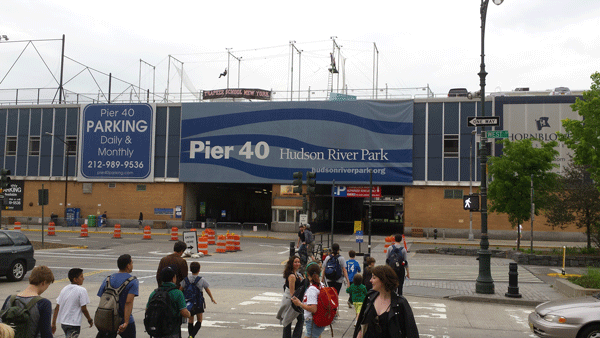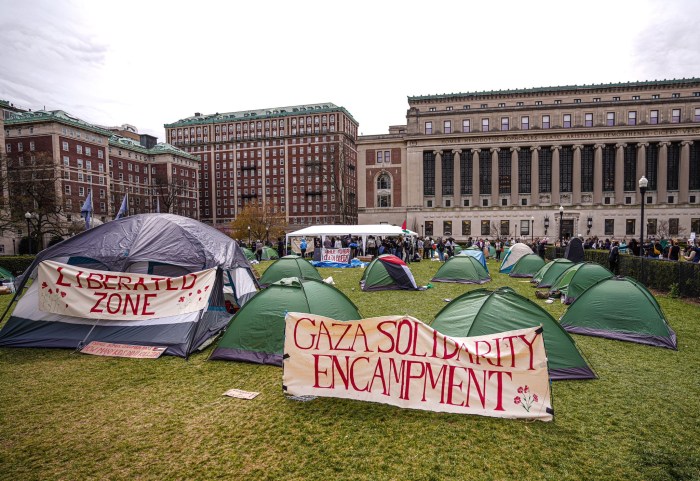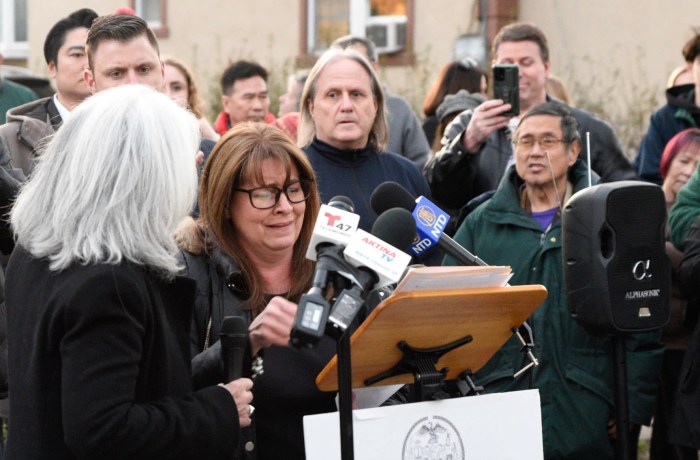
BY LINCOLN ANDERSON | The fallout continues to mount over the secret agreement to transfer $100 million worth of air rights from Pier 40 in Hudson River Park across the highway to the St. John’s Center site.
The signed agreement has yet to be produced — despite politicians’ repeated demands to see it. The president of the Hudson River Park Trust is in hot water over the hush-hush deal — with a local assemblymember declaring the Trust leader has lost the community’s trust. Meanwhile, an engineering study of Pier 40, set to be released June 15, reportedly will say that, without major repairs, the hulking structure has only two years of life left, after which it might well collapse into the water — and that public use of the pier might have to be shut down as early as this summer.
On top of all that, The Villager has learned that a community lawsuit may soon be filed in an attempt to derail the stealth Pier 40 air-rights sale plan completely.
An article two weeks ago in The New York Times blew the lid off the story, reporting that a memorandum of understanding, or M.O.U., for the air-rights deal had, in fact, been signed six months earlier by the Empire State Development Corporation — the state’s development agency — the Trust and Atlas Capital Group, a partner in the St. John’s Center, at 550 Washington St. Local politicians, who only learned about the M.O.U. from an offhand remark that an E.S.D.C. official let slip at a meeting that same day, were stunned to find out about it.
Of particular concern, Governor Cuomo and E.S.D.C. are pushing for what’s known as a General Project Plan for the air-rights transfer and redevelopment of the St. John’s Center site, meaning there would be no binding city review, known as Uniform Land Use Review Procedure.
Meanwhile, two weeks later, the M.O.U. still has not been seen, not even by the politicians, including Congressmember Jerrold Nadler, who have been requesting a look at it.
On May 21, in a unified front, a total of 10 local pols wrote to Kenneth Adams, the president and C.E.O. of E.S.D.C.
“The M.O.U. was apparently signed in anticipation of the transfer of air rights through a General Project Plan (“G.P.P.”) from Pier 40 in the Hudson River Park to the building,” the elected officials wrote. “We requested a copy of the M.O.U. at a meeting on Friday, May 16, and were promised by a representative of E.S.D.C. that it would be sent immediately.”
The letter was signed by Nadler, Borough President Gale Brewer, state Senators Brad Hoylman and Daniel Squadron, Assemblymembers Deborah Glick, Richard Gottfried and Linda Rosenthal, and City Councilmembers Corey Johnson, Margaret Chin and Helen Rosenthal.
Still being stonewalled as of this Wednesday, the politicians now plan to file a Freedom of Information Law, or FOIL, request soon to obtain a copy of the document.
It’s especially surprising that even Brewer hasn’t seen the agreement. As borough president, she controls the appointment of three members on the Trust’s board of directors.
E.S.D.C., the Trust and Atlas all declined to comment for this article — much less specifically answer the question: Will the M.O.U. ever be produced?
Part of the argument for a G.P.P. that Cuomo and E.S.D.C. are making — at least publicly — is that it’s more “timely,” as in, everything will get done more quickly than in ULURP, which requires reviews and advisory recommendations by the local community boards and borough president, plus further reviews and binding votes by the City Planning Commission and City Council.
Under the air-rights legislation that was stealthily and hurriedly passed in the state Legislature last year, the money from Pier 40’s air-rights sales specifically have to be funneled back into repairs and maintenance of the dilapidated 14-acre pier. G.P.P. proponents say the pier won’t last unless the air-transfer deal is done A.S.A.P., generating the huge cash windfall for the pier.
However, this Tuesday, attorney Arthur Schwartz told The Villager he is currently looking into a lawsuit to stop the plan in its tracks. The amendment regarding air-rights transfers states that the transfers must be done “to the extent designated and permitted under local zoning ordinances” — although the word “ULURP” is not expressly stated.
Even if the legislation could be construed not to require ULURP and Cuomo tries to ram a quick G.P.P. through, Schwartz said a potentially lengthy environmental review — known as an Environmental Impact Statement, or E.I.S. — likely would be required.
“There could be an argument that this has to go through an E.I.S.,” he said. “I’m sure a G.P.P. of sufficient size requires an E.I.S. A full-blown E.I.S. could take years.
“I once stopped a state project because of an E.I.S. Costco was going to go on 14th St.,” he noted.
The 14th St. site was then home to a state armory. Not wanting to go through a time-consuming E.I.S., Costco — which neighbors feared would generate heavy auto traffic — pulled out. A lower-impact use came in.
“Then we got the Y,” he said, “and that was fine with me and people that live there.”
Similarly, the rooftop sports field at Pier 40 was the settlement of a lawsuit Schwartz brought against the state. In that one, the suit charged there had been no E.I.S. done for the pier when it was leased to parking operators Ben Korman and Meir Cohen.
“I was just part of a team that just knocked out the New York Public Library plan. The library hadn’t done an E.I.S.,” Schwartz added. That plan would have seen seven stories of underground stacks replaced with circulating-library uses — basically, cramming two other libraries into the bottom of the main branch.
In short, when it comes to E.I.S. lawsuits, Schwartz’s record is quite good.
As for who might be the plaintiffs on the potential G.P.P. suit, Schwartz said, “Don’t know yet. But I’m sure I could find a few. Maybe I’d put an ad in The Villager,” he quipped. “Maybe G.V.S.H.P.”
Andrew Berman, executive director of the Greenwich Village Society for Historic Preservation, was not ready this week to say if his group would definitely be a party to the lawsuit, though it sounded like it was on his mind, if not the tip of his tongue.
“This focus on selling air rights as a way of funding the park opens up a world of troubling possibilities,” the preservationist said.
As for Atlas Capital Group, it’s part of an ownership partnership of the three-block-long St. John’s Center building, the other members being Fortress Investment Group and Westbrook Partners.
Michael Novogratz, a principal with Fortress, is the chairperson of the board of directors of the Friends of Hudson River Park — the 5-mile-long park’s main private fundraising group — and was formerly a member of the Trust’s board of directors.
Novogratz, like other local youth sports advocates — such as the Pier 40 Champions group — has been very open about his fervent hope to see Pier 40 fixed up and preserved as a local mecca for youth sports — and sports in general. Known as “Novo” for short, he’s the founder of Beat the Streets, a nonprofit that promotes youth wrestling programs in the city.
Reportedly driving the push for a G.P.P. is the fact that clarifying how the park air-rights transfers will work will take time.
“It will take years of studying to create the mechanism to transfer air rights,” said a source familiar with the plan, speaking on condition of anonymity. “Pier 40 might not be around anymore by then.”
Meanwhile, the pier reportedly needs $100 million in repairs, and at least $44 million to repair the most critically decayed steel support pilings.
What Cuomo, E.S.D.C. and the Trust want is actually a “modified G.P.P.,” explained the source. There would be a review by City Planning, by something called a “consultative council,” plus the borough president and so forth — but apparently none of these would be binding.
Discussions between the three parties, as well as the Bloomberg administration, started a year ago and were ongoing, the source said. Bloomberg was on board with the modified G.P.P., but Mayor de Blasio’s deputy mayor for economic development, Alicia Glen, has now called for city review of the plan. Yet, Glen apparently did not use the word “ULURP,” per se.
Assembylmember Glick said she still supports the idea of air-rights sales, though she has previously said it wasn’t her first choice for how to solve the park’s cash woes. But she said she’s adamantly against a G.P.P.
“The transfer of air rights and the money for the park is a good thing,” she said this week.
The first rumblings that a G.P.P. was being mulled came last October and November.
“We told them, ‘You’re better off going through a ULURP, that is, a process — the community board, the borough president, City Planning, the City Council weigh in,” Glick said the politicians told the parties back then. “We said, ‘There will be lawsuits.’… We thought it was dead.”
Recently, though, the rumblings started up again, and so, earlier this month, the pols wrote a joint letter objecting to a G.P.P., only to find out through the Times article, and at the May 16 meeting, that a G.P.P. was exactly what had been agreed to behind their backs. And still no one has seen the M.O.U.
“It’s another indicator that the Trust has operated in bad faith,” she said of the secret agreement that no one has seen yet.
As for the forthcoming Pier 40 study that reportedly will say the pier is kaput and will need to be closed soon, possibly even by this summer, Glick scoffed, “Everything the Trust has ever said about Pier 40 has been a means of terrorizing the community so that the Trust gets its desired action.”
She said the park authority should cut the fear campaign and immediately start fixing Pier 40’s most-damaged piles, since every day of delay just causes them to deteriorate more.
“This is a critical need for the entire West Side and kids and families all over Manhattan,” she said of the pier. “This is essential and critical infrastructure.”
Of Trust president Madelyn Wils, who personally signed the M.O.U., Glick said, “This latest revelation has shaken the community’s belief in their ability to work with someone who has been less than forthcoming. There are people that felt a real sense of betrayal. I think she has seriously undermined her ability to be effective with the community.”
State Senator Hoylman said, “It’s beyond ridiculous that we were promised the M.O.U. two weeks ago and haven’t received it. I think it’s beyond preposterous that we have to FOIL our own government, our employer, for information. None of this inspires confidence in this process, which is tragic, given the needs of the park.
“Obviously,” Hoylman said, “the Bloomberg administration worked to put something in place before they left office — but I don’t know what it is because no one has seen the M.O.U. yet!”

















